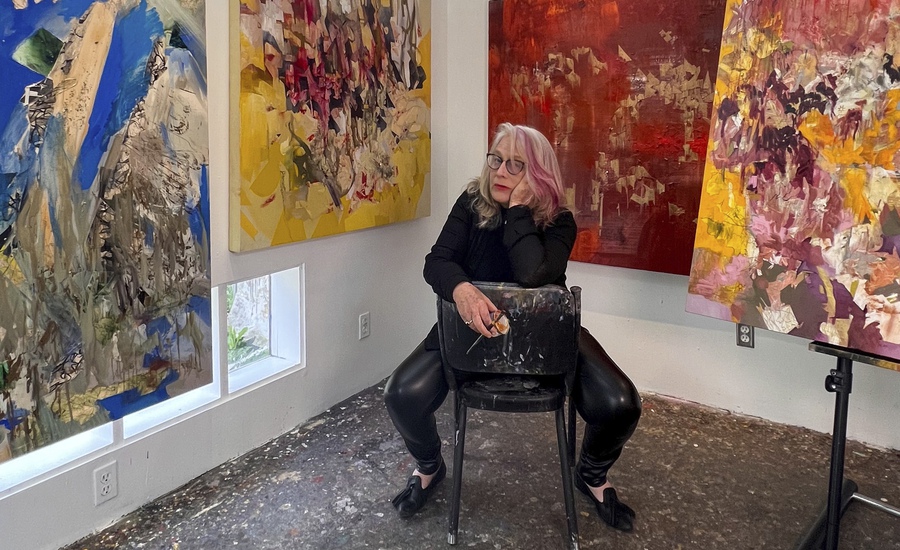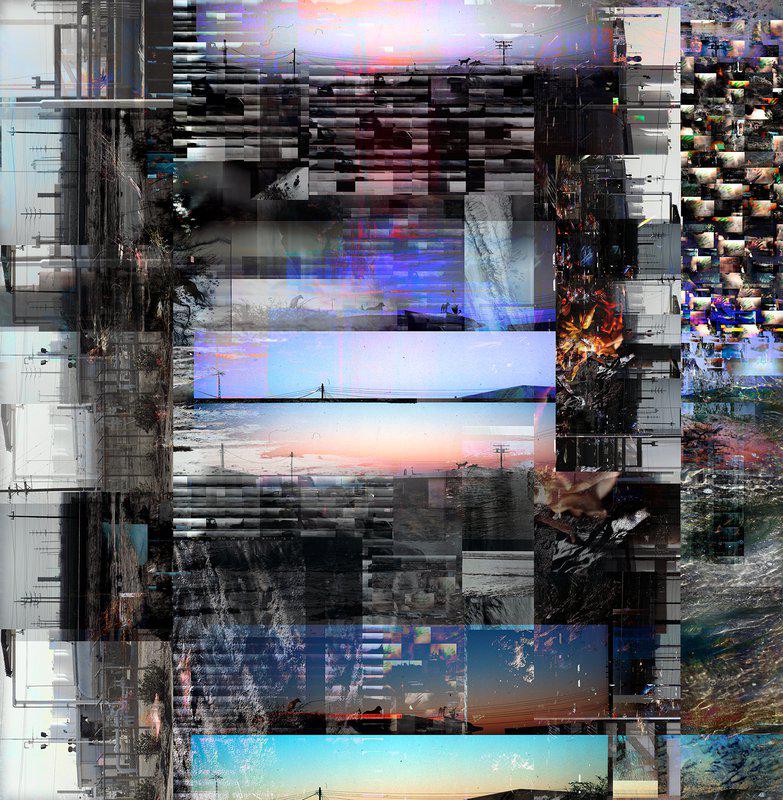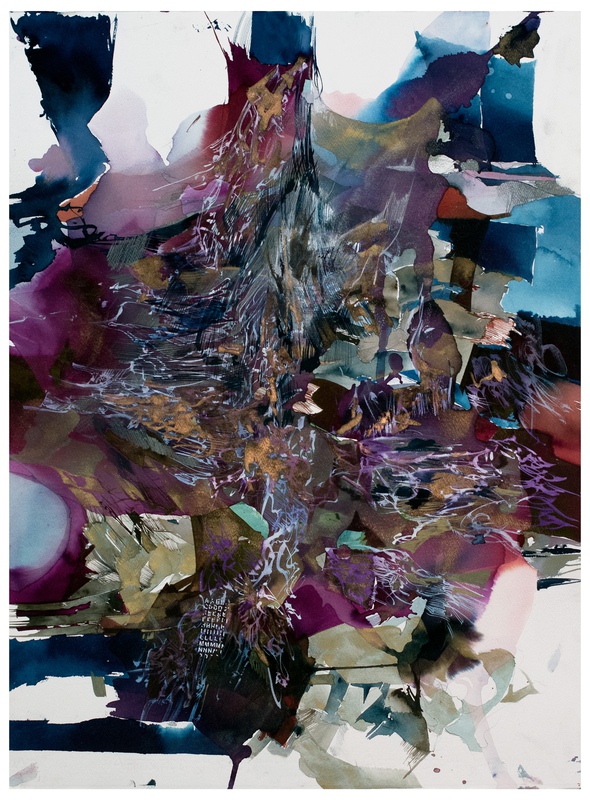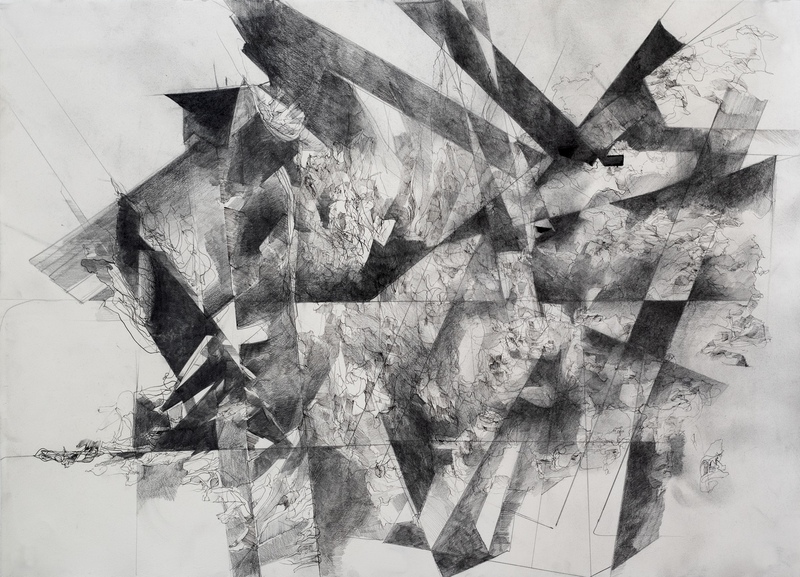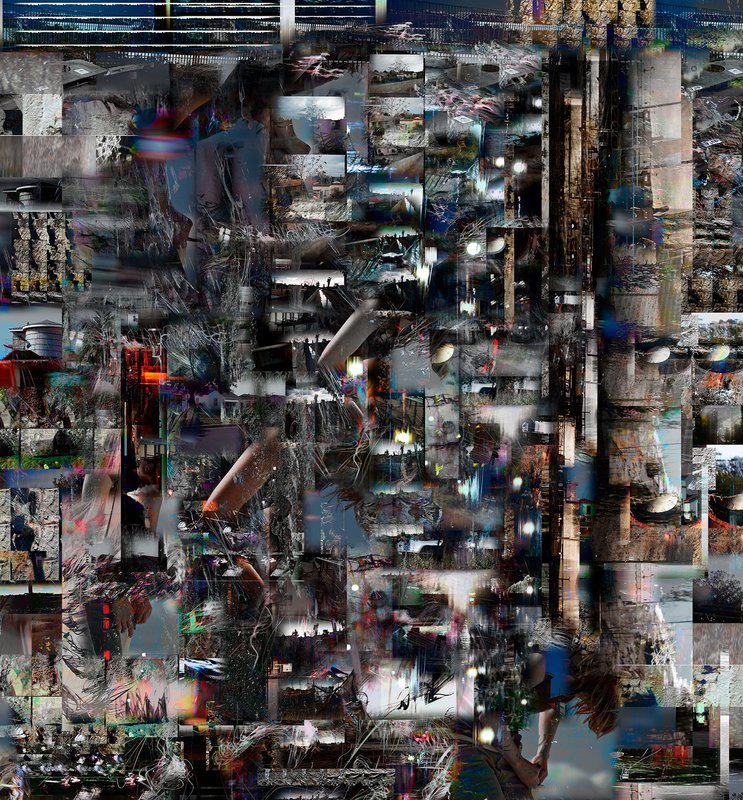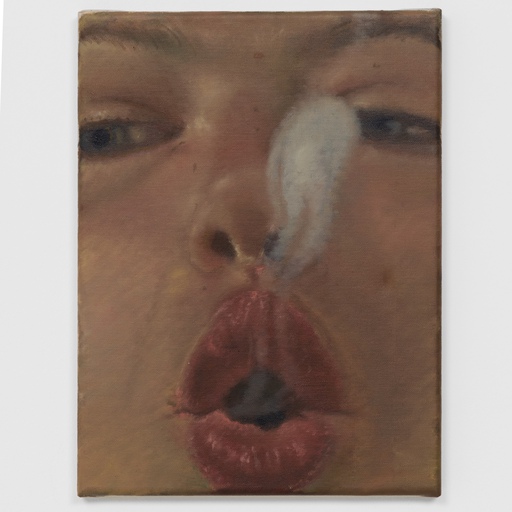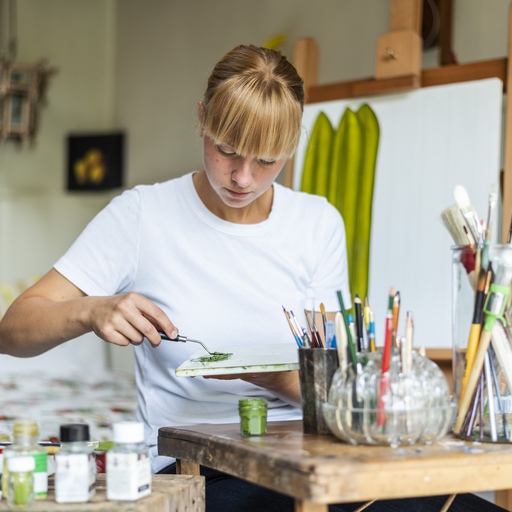“Constructing a painting is like trying to map an ecology of sensations, almost to score a place–a shimmer of light, a shadow, the way things looked and felt, the way phenomena shape-shift orientation,” the Californian artist Christina McPhee tells us.
McPhee’s abstract compositions are built up within a matrix of fractured surfaces, vibrant colors, and a web-like layering of transparent effects. Although she works across a range of media, the drawn line is always central, forming a connective tissue within and between works.
Her dynamic, performative, physical engagement with materials, in both her analogue and digital works, is a seduction into surface-skidding calligraphic gestures and mark-making. Her photography, involved with imaging crushed and pinned drawings, has a forensic atmosphere, and calls into question perception, and the creative act itself.
The curator Beth Venn, summed up her work eloquently when she said: “Christina McPhee makes collapsing and regenerating landscapes that blend technological precision with notions about place-making and interspecies community.”
CHRISTINA MCPHEE - Marine Layers Border Patrol, 2019
Her work is housed in museum and private collections around the world, including: the Whitney Museum of American Art, Rhizome Arbase at the New Museum, International Center for Photography, New York; Kemper Museum of Contemporary Art, Kansas City; Williamson Gallery at Scripps College, Claremont, California; and Thresholds New Media Collection, Scotland.
In this interview, published to announce McPhee's inclusion in Artspace's Artist Direct program, which offers straightforward access to under-discovered and rising art stars' work; she describes how a media-free existence as a child led her to be inspired by both books and the clouds above her, how what she describes as 'the inner life of abstraction' guides her work and why artists–and all of us– really should not fear AI.
How would you describe your work to someone who has never seen it? Across painting, photomontage, and video, my core practice is in drawing. Drawing is a way into worlds of kinetic connection. And I'm obsessed with abstraction in drawing and painting, because it holds an interiority, an inner life. Constructing landscapes is an ecology of affect–emotion–and inductive logic, it's an investigation and a question, or layers of questions. I perform mark-making through archives of sound, voice, spoken word: articulating a sense of layers in time and space.
CHRISTINA - MCPHEE -
Double Blind 62A Soda Lake,
2023

What made you want to become an artist? In childhood, I remember coming into new worlds with books. I was drawn into stories of Hester Street and the immigrant tenements of New York; apocalyptic novels like On the Beach and A Canticle for Liebowitz; fantasies of language; tesseracts in Madeline L’Engle’s A Wrinkle in Time; and real-world shock (The Diary of Anne Frank). Nobody monitored my reading—it was free space. I imagined doors in time. I remember reading a small, cerulean-blue book about Einstein’s theory of relativity. I watched cumulus clouds gather in summer afternoons. I thought I was watching past worlds up there.
I remember building a model, cutting up note cards and joining with tape, of the underground city of the dead at Saqqara. At school, the Bible was to be memorized. At home, we lived a media-free existence. I saved up enough money from my allowance for a ticket to see Dr. Zhivago. Between layers of cosmic abstraction and human story I was snared and seduced into drawing. I learned to shape visual processing as an antidote to conformity. My first art book was a catalog from the late forties, Van Gogh at Auvers, the asylum where he made his late works. I poured over his marks.
CHRISTINA MCPHEE - Ineluctable Valentine, 2023
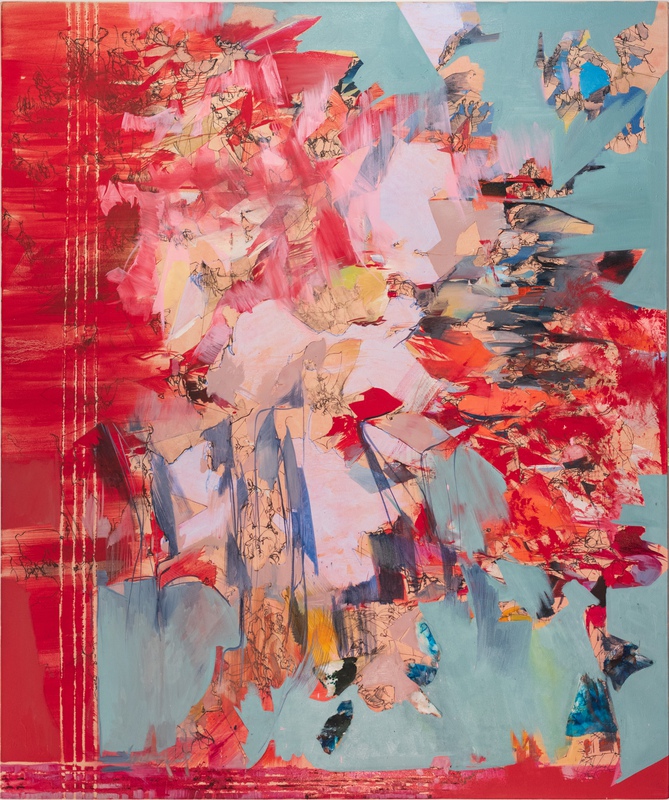
What was your earliest art creation? My first memory: I was watching clothes drying on a sunny day in Los Angeles, with my mom. I remember drawing how the shirts were hanging on the clothesline. She saved a drawing from when I was four: in bright red, green and blue crayon, the continents in blobs. That’s the first drawing.
What are the current things going on that are inspiring you? If artificial intelligence gives us what we say we want, gives us a derivative of our desires, then weirdly, what we get back is projection. What we want is what we get, such a perfect commodity. Seductive but also kind of zombified! If painting is made up of thousands of idiosyncratic decisions and moments that don't necessarily correlate to one another, then that’s freedom, I mean, there’s always something that escapes repetition and reproduction.
Constructing a painting is like trying to map an ecology of sensations, almost to score a place–shimmer of light, a shadow, the way things look in the nearly pitch dark, dusk, dawn, desert, ocean, disappearing, the way things looked and felt, the way phenomena shape-shift orientation. The process of making has an element of shock, or disorientation, as the successful painting gives something back that won't resolve into a condition of predictability. It stays wild. Drawing is like that too, perhaps even more so.
This is where painting and drawing do something that AI may not. People seem to be very worried that AI is going to take over, or that it will ‘decide’ to eliminate us. This seems a little paranoid to me because it seems evident that AI is our own inspired creation— it’s just a very capacious, efficient way to correlate one received idea to another, in a series of decisions or choices that begin with us, and our choices; so it only can know or discover what we humans already know and discover already.
CHRISTINA MCPHEE - Where for Twelve Years Hummingbirds, 2019
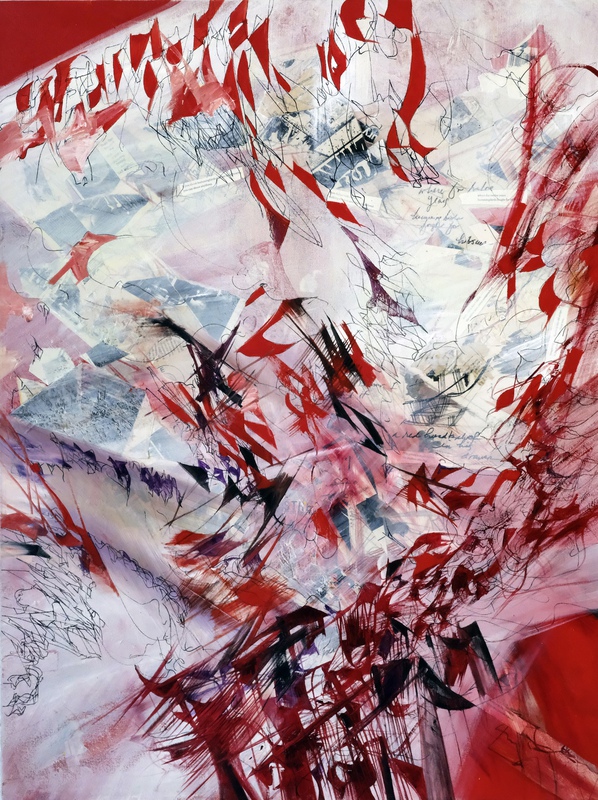
Could you describe your process, or a typical working day? I live on an acre of land on the central coast of California, in the territory of Chumash and Salinan First Nations. I’m surrounded by ancient oaks and chaparral and bird life. Terry, my partner, builds large scale stretchers by hand. Three layers of transparent glue ground follow.
This is where the painting begins, with the ground, and then something exciting happens between the second and third layer, I collage paper fragments into the wet glue. I cut up bits of vintage printed matter. I make multiple cuts with exacto knife or scissors. I throw the fragments in scatter-zones across the surface. When collage occurs from calligraphy ink drawings on Japanese papers, ink spreads and stains around these patches.
Once dry, I haul canvasses into my studio, the Shed, a space taller than it is wide, and lit via clerestory windows and skylights. The collage elements call for looking at close range. I start drawing with ink and graphite into this field. I try to keep my attitude toward the canvas open, as the canvas is an open field, at this early point. I start to draw connections between the fragments of collage.
As I draw, in ink and graphite, I set up grids of lines and vectors that start to transect the surface into illusions of deep space. I enter a meditative state of mind. I listen to spoken word content; I draw to voice. Sometimes, music. Caroline Shaw, Andrew McIntosh, and Julius Eastman are among the contemporary composers currently on repeat. I listen to stories by Lidia Yuknavitch and Toni Morrison (among many).
CHRISTINA MCPHEE - Voice Print 5 (Calligraphic Flood) 2023
I work in five- or six-hour sessions. I work until dark. Sometimes I pull a late night. past midnight. I use color balanced LED side lights for detailed illumination at night.
As I work in the Shed, I shoot details of work in progress. Later when a body of work develops, maybe ten or more paintings and large-scale drawings, I take formal photographs of each with a medium format camera. I may keep working on a painting, to the point that I lose it, but if I archive a medium format process shot, I will remix this lost content digitally. I print back out of the digital negative or positive into gelatin silver prints, type C chromogenic light jet, and pigment prints on paper.
What are the bits of being a fine artist you struggle with? The hardest part is to speak as if on behalf of my work. Christopher Bollas studied how people with ‘normotic’ illness need, to an extreme degree, outside validation for their interests and perceptions. My mother gave me a key to practice: whenever, as a little girl, I was angry or hurt, she’d tell me to ‘go draw it out’. Through drawing I escaped the pressure to conform to expectation, and on the negative side, to sublimate my sense of being in the world. One series of drawings and paintings I return to is called ‘drama of erasure.’ That could be both about the sublimation of thoughts into visual display as a cover for realities— to displace or hide— and also, about the performing action of taking the experience of life into nonverbal registers.
CHRISTINA MCPHEE - Inflated Tear (After Rahsaan Roland Kirk), 2023
Tell us a little about three of your works on Artspace A 'listening' drawing traces the motion of the sun across paper, and layers marks responding to the intensities of voice and emotion transmitted through an online performance. The late Rahsaan Roland Kirk played tripling chords by blowing three saxophones at once. “Inflated Tear’ condenses the heartbreak of blues into liquid sound. His chords tear through the steely grids of a construction site built on sorrow and joy. The music transmits his resilience, the drawing, a topography of the transmission. Kirk said he would emulate the sounds he heard in his head. First hearing this music at the age of nineteen, I felt its shapes imprint on my mind, blueprint for a future life.
CHRISTINA MCPHEE - L’aventura Searise (The Red Shoes), photomontage, chromogenic print 2011
Holes. Time warps. Tesseracts. Places you can’t find on a map because they are to come or are disappeared. Places where the sound environment is cyclical and rhythmic. Machines, like oil derricks, creaking as they move up and down. Sucking up the oil, which is hidden in the tubes, lines and tanks of the oil field.
At sea, the drift of oil down through the photosynthetic layer, down to the benthic layer where the crustacea live, and the sightless fish. In this photomontage, I’m imagining what comes up from the depths, as oceans rise in response to greenhouse gas concentrations.
This print (above) is from the Tesserae of Venus project 2009-2011, imagining the saturated atmospheres of greenhouse gasses and climate change. This series is composed of photographs shot at energy producing remote sites in California.
CHRISTINA MCPHEE - Codex Entrada (Iguanas and Macaws), archival inkjet print, 2023
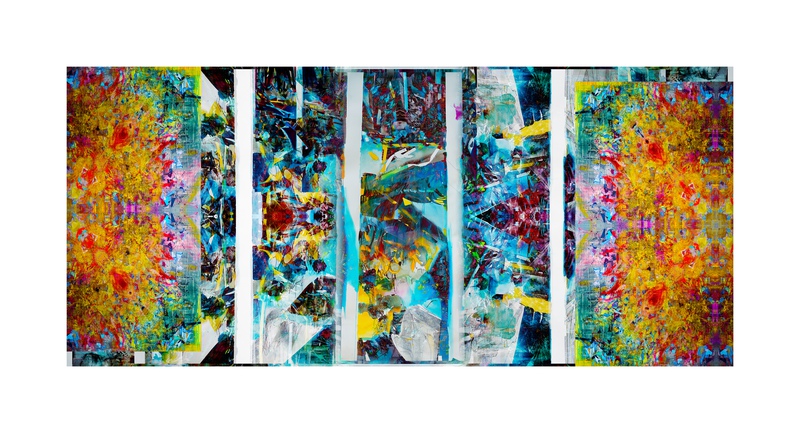 Architecturally resonant, photographic fragments I shoot of my paintings in studio process are the raw material for the codex multiples. ‘Entrada’ evokes an entrance, and also the colonial overtaking of the Americas, especially when paired with “codex”, or pictorial notation of shared, grassroots, possibly secret histories and systems. The print image builds from a basis of a single shot of a large-scale watercolor, saturated in aqua, sunny yellows, and scarlet. Colors recalling macaws in clusters, rustling and nesting in the forest shade. On either side, like guardians of a portal, messages of lizards bask in the sun.
Architecturally resonant, photographic fragments I shoot of my paintings in studio process are the raw material for the codex multiples. ‘Entrada’ evokes an entrance, and also the colonial overtaking of the Americas, especially when paired with “codex”, or pictorial notation of shared, grassroots, possibly secret histories and systems. The print image builds from a basis of a single shot of a large-scale watercolor, saturated in aqua, sunny yellows, and scarlet. Colors recalling macaws in clusters, rustling and nesting in the forest shade. On either side, like guardians of a portal, messages of lizards bask in the sun.
How has your work changed over the course of your career? I remember mapping a landscape with color marks (with watercolor, watercolor crayons and oils pastels on paper), using projections of slides I’d shot at Bryce Canyon, in southern Utah. Bryce Canyon is famous for its millions of delicate spires. These form steadily through millennia of erosion, without tectonic drama. I had a sensation of taking notes directly from a natural ‘drawing’, like a transcription. Afterwards I was in a panic: where else could I work as if in receipt of a transmission? Most of what I have done since then arises, in part, from a productive anxiety towards the genre of landscape.
CHRISTINA MCPHEE - Tying Wetlands, 2019
Do you collect art yourself or something that you consider art? If so, what have you bought lately? My first piece came as a surprise. I was a graduate student in Boston, where Philip Guston would come once a month for crits. One day, over lunch at Legal Seafoods, Philip made me a drawing of a motif I was working on at the time—Icarus falling out of the sky into the ocean. He liked how I was drawing the doomed boy’s feet, toes out like spikes. He said he’d never thought of taking on the Icarus motif. So he drew one for me. His Icarus is crashing into the menu bordered by lobsters and derelict ships.
Lately I’ve been collecting works on paper - drawings, collages, silkscreens, etchings — by Carolyn Castano (Los Angeles), Esperanza Mayobre (New York/Caracas), Rodney Ewing (San Francisco/New York), Madeleine Ignon (Los Angeles/Santa Barbara), Xio Martin (Philadelphia), Bessie Kunath (Cleveland), Nova Jiang (Los Angeles), and Jenny Perlin (New York). On my wish list: Phil King (London/Lourdes) and Garry Noland (Kansas City). In a perfect world, I’d live with a drawing by Derek Jarman.
What are you working on at the moment? A new project is in the works, “Feralysis Theatre” that riffs on construction drawings by the late American architect and theorist Charles Moore for an unbuilt performing art center in southern California. So far, ironically, it exists only in words.
Take a look at Christina McPhee's artist page on Artspace here.











